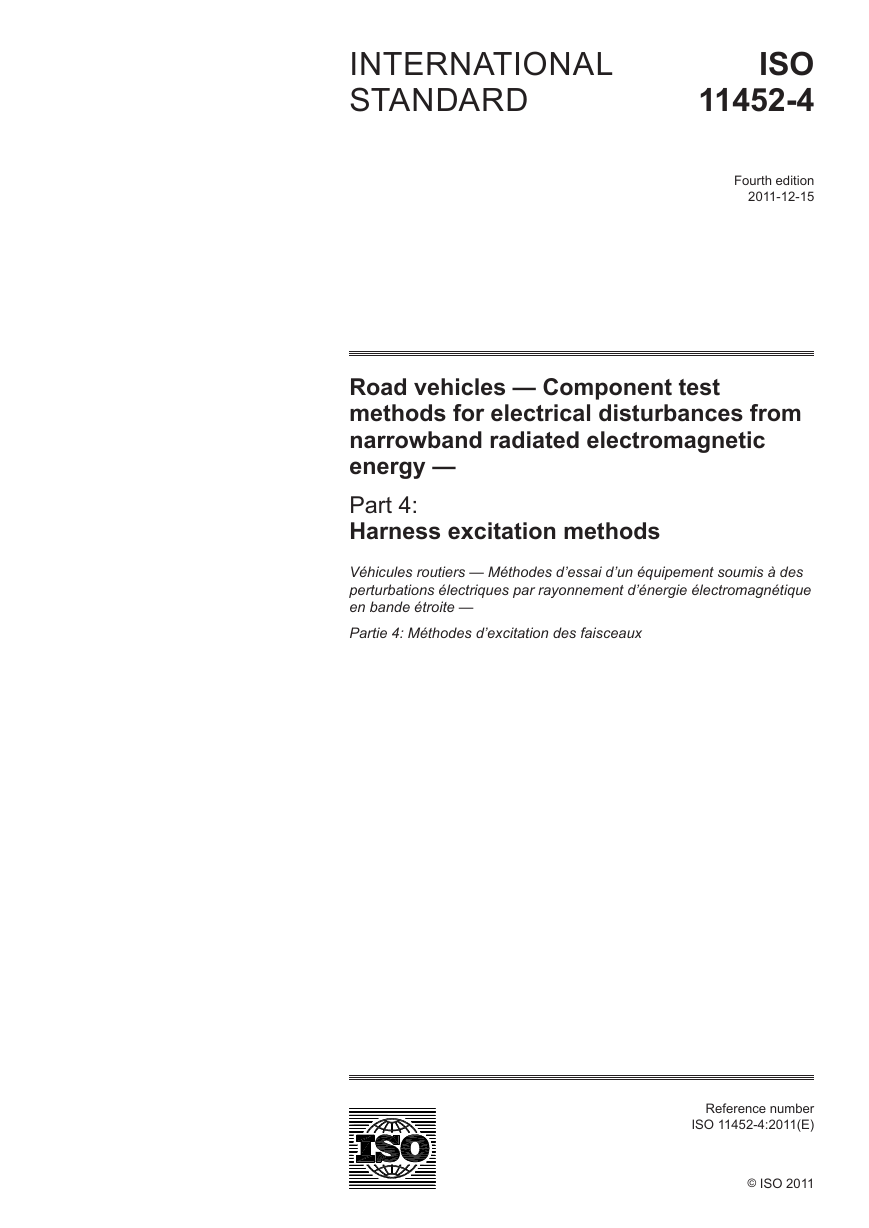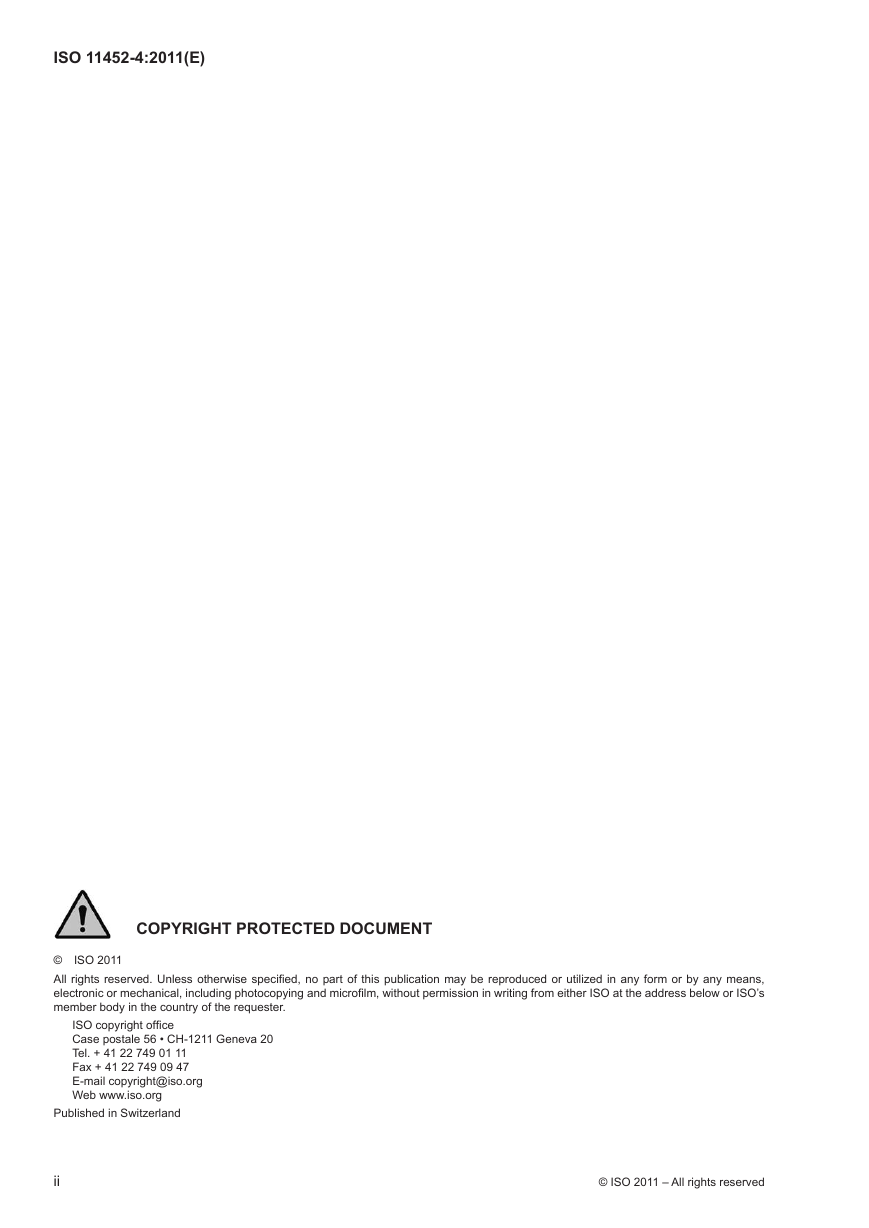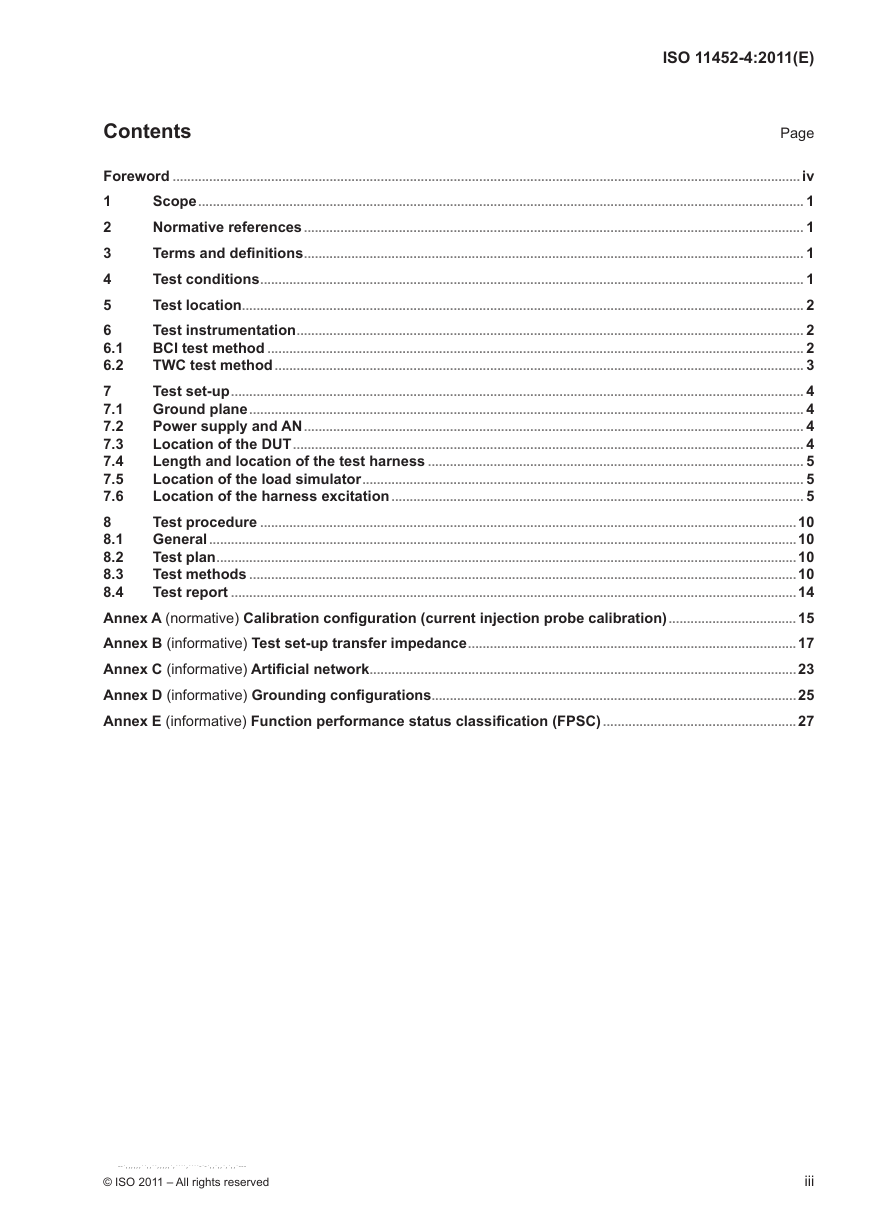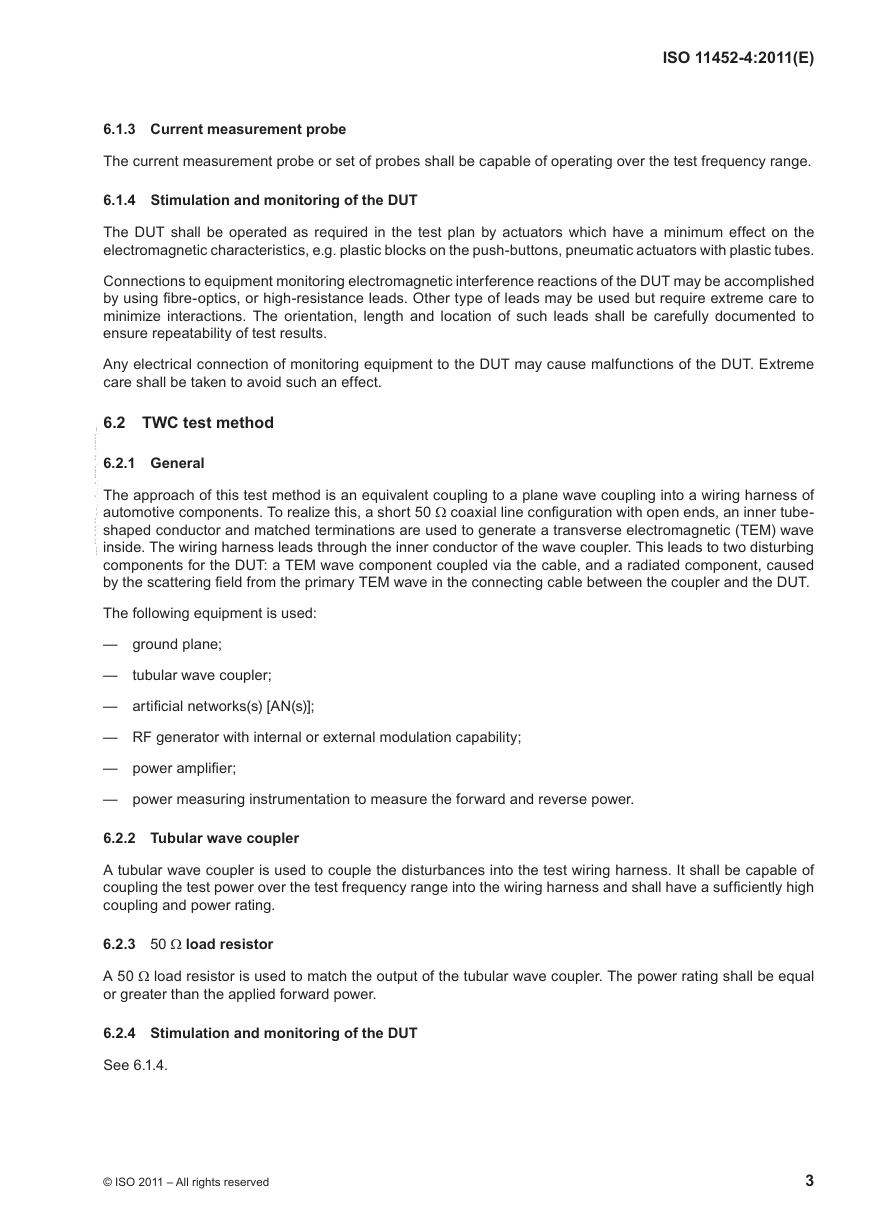INTERNATIONAL
STANDARD
ISO
11452-4
Fourth edition
2011-12-15
Road vehicles — Component test
methods for electrical disturbances from
narrowband radiated electromagnetic
energy —
Part 4:
Harness excitation methods
Véhicules routiers — Méthodes d’essai d’un équipement soumis à des
perturbations électriques par rayonnement d’énergie électromagnétique
en bande étroite —
Partie 4: Méthodes d’excitation des faisceaux
Reference number
ISO 11452-4:2011(E)
© ISO 2011
�
ISO 11452-4:2011(E)
COPYRIGHT PROTECTED DOCUMENT
ISO 2011
©
All rights reserved. Unless otherwise specified, no part of this publication may be reproduced or utilized in any form or by any means,
electronic or mechanical, including photocopying and microfilm, without permission in writing from either ISO at the address below or ISO’s
member body in the country of the requester.
ISO copyright office
Case postale 56 • CH-1211 Geneva 20
Tel. + 41 22 749 01 11
Fax + 41 22 749 09 47
E-mail copyright@iso.org
Web www.iso.org
Published in Switzerland
ii
© ISO 2011 – All rights reserved
�
Contents
ISO 11452-4:2011(E)
Page
Foreword ............................................................................................................................................................................iv
Scope ...................................................................................................................................................................... 1
1
Normative references ......................................................................................................................................... 1
2
Terms and definitions ......................................................................................................................................... 1
3
Test conditions ..................................................................................................................................................... 1
4
Test location .......................................................................................................................................................... 2
5
Test instrumentation ........................................................................................................................................... 2
6
BCI test method ................................................................................................................................................... 2
6.1
TWC test method ................................................................................................................................................. 3
6.2
Test set-up ............................................................................................................................................................. 4
7
7.1
Ground plane ........................................................................................................................................................ 4
Power supply and AN ......................................................................................................................................... 4
7.2
Location of the DUT ............................................................................................................................................ 4
7.3
Length and location of the test harness ....................................................................................................... 5
7.4
7.5
Location of the load simulator ......................................................................................................................... 5
Location of the harness excitation ................................................................................................................. 5
7.6
Test procedure ...................................................................................................................................................10
8
General .................................................................................................................................................................10
8.1
8.2
Test plan ...............................................................................................................................................................10
Test methods ......................................................................................................................................................10
8.3
8.4
Test report ...........................................................................................................................................................14
Annex A (normative) Calibration configuration (current injection probe calibration) ...................................15
Annex B (informative) Test set-up transfer impedance ..........................................................................................17
Annex C (informative) Artificial network .....................................................................................................................23
Annex D (informative) Grounding configurations ....................................................................................................25
Annex E (informative) Function performance status classification (FPSC) .....................................................27
© ISO 2011 – All rights reserved
iii
--`,,,,,,``,,``,,,,,`,````,````-`-`,,`,,`,`,,`---�
ISO 11452-4:2011(E)
Foreword
ISO (the International Organization for Standardization) is a worldwide federation of national standards bodies
(ISO member bodies). The work of preparing International Standards is normally carried out through ISO
technical committees. Each member body interested in a subject for which a technical committee has been
established has the right to be represented on that committee. International organizations, governmental and
non-governmental, in liaison with ISO, also take part in the work. ISO collaborates closely with the International
Electrotechnical Commission (IEC) on all matters of electrotechnical standardization.
International Standards are drafted in accordance with the rules given in the ISO/IEC Directives, Part 2.
The main task of technical committees is to prepare International Standards. Draft International Standards
adopted by the technical committees are circulated to the member bodies for voting. Publication as an
International Standard requires approval by at least 75 % of the member bodies casting a vote.
Attention is drawn to the possibility that some of the elements of this document may be the subject of patent
rights. ISO shall not be held responsible for identifying any or all such patent rights.
ISO 11452-4 was prepared by Technical Committee ISO/TC 22, Road vehicles, Subcommittee SC 3, Electrical
and electronic equipment.
This fourth edition cancels and replaces the third edition (ISO 11452-4:2005), which has been technically
revised.
ISO 11452 consists of the following parts, under the general title Road vehicles — Component test methods for
electrical disturbances from narrowband radiated electromagnetic energy:
— Part 1: General principles and terminology
— Part 2: Absorber-lined shielded enclosure
— Part 3: Transverse electromagnetic (TEM) cell
— Part 4: Harness excitation methods
— Part 5: Stripline
— Part 7: Direct radio frequency (RF) power injection
— Part 8: Immunity to magnetic fields
— Part 9: Portable transmitters
— Part 10: Immunity to conducted disturbances in the extended audio frequency range
— Part 11: Reverberation chamber
iv
© ISO 2011 – All rights reserved
--`,,,,,,``,,``,,,,,`,````,````-`-`,,`,,`,`,,`---�
INTERNATIONAL STANDARD
ISO 11452-4:2011(E)
Road vehicles — Component test methods for electrical
disturbances from narrowband radiated electromagnetic
energy —
Part 4:
Harness excitation methods
1 Scope
This part of ISO 11452 specifies harness excitation test methods and procedures for determining the immunity
of electronic components of passenger cars and commercial vehicles regardless of the propulsion system (e.g.
spark-ignition engine, diesel engine, electric motor).
The bulk current injection (BCI) test method is based on current injection into the wiring harness using a current
probe as a transformer where the harness forms the secondary winding.
The tubular wave coupler (TWC) test method is based on a wave coupling into the wiring harness using
the directional coupler principle. The TWC test method was developed for immunity testing of automotive
components with respect to radiated disturbances in the GHz ranges (GSM bands, UMTS, ISM 2,4 GHz). It is
best suited to small (with respect to wavelength) and shielded device under test (DUT), since in these cases the
dominating coupling mechanism is via the harness. For DUTs which are larger than a wavelength (e.g. 0,1 m at
3 GHz), direct field coupling to the printed circuit board (PCB) becomes of equal importance. The user of the
TWC test method should take this into account and determine the applicability of the method.
The electromagnetic disturbances considered in this part of ISO 11452 are limited to continuous narrowband
electromagnetic fields.
2 Normative references
The following referenced documents are indispensable for the application of this document. For dated
references, only the edition cited applies. For undated references, the latest edition of the referenced document
(including any amendments) applies.
ISO 11452-1:2005, Road vehicles — Component test methods for electrical disturbances from narrowband
radiated electromagnetic energy — Part 1: General principles and terminology
3 Terms and definitions
For the purposes of this document, the terms and definitions given in ISO 11452-1 apply.
4 Test conditions
The applicable frequency ranges of the BCI and the TWC test methods are direct functions of the transducer
characteristics (current probe or tubular wave coupler). More than one type of transducer may be required.
To test automotive electronic systems, the typical applicable frequency range
— of the BCI test method is 1 MHz to 400 MHz,
— of the TWC test method is 400 MHz to 3 GHz.
© ISO 2011 – All rights reserved
1
--`,,,,,,``,,``,,,,,`,````,````-`-`,,`,,`,`,,`---�
ISO 11452-4:2011(E)
NOTE
Current probes and tubular wave couplers are available which allow testing outside these frequency ranges.
The users shall specify the test severity level(s) over the frequency range. Suggested test levels are included
in Annex E.
Standard test conditions are given in ISO 11452-1 for the following:
—
test temperature;
— supply voltage;
— modulation;
— dwell time;
—
frequency step sizes;
— definition of test severity levels;
—
test signal quality.
5 Test location
The tests shall be performed in a shielded enclosure.
6 Test instrumentation
6.1 BCI test method
6.1.1 General
BCI is a method of carrying out immunity tests by inducing disturbance signals directly into the wiring harness
by means of a current injection probe. The injection probe is a current transformer through which the wiring
harnesses of the device under test (DUT) are passed. Immunity tests are carried out by varying the test
severity level and frequency of the induced disturbance.
The following equipment is used:
— ground plane;
— current injection probe(s);
— current measurement probe(s);
— artificial network(s) [AN(s)];
—
radio frequency (RF) generator with internal or external modulation capability;
— power amplifier;
— power measuring instrumentation to measure the forward and reverse power;
— current measurement equipment.
6.1.2
Injection probe
An injection probe or set of probes capable of operating over the test frequency range is required to couple
the test signal to the DUT. The probe(s) shall be capable of withstanding the necessary input power for the
maximum test level over the test frequency range regardless of the test set-up loading.
Saturation of the injection probe should be taken into consideration in establishing the test levels.
2
© ISO 2011 – All rights reserved
--`,,,,,,``,,``,,,,,`,````,````-`-`,,`,,`,`,,`---�
ISO 11452-4:2011(E)
6.1.3 Current measurement probe
The current measurement probe or set of probes shall be capable of operating over the test frequency range.
6.1.4 Stimulation and monitoring of the DUT
The DUT shall be operated as required in the test plan by actuators which have a minimum effect on the
electromagnetic characteristics, e.g. plastic blocks on the push-buttons, pneumatic actuators with plastic tubes.
Connections to equipment monitoring electromagnetic interference reactions of the DUT may be accomplished
by using fibre-optics, or high-resistance leads. Other type of leads may be used but require extreme care to
minimize interactions. The orientation, length and location of such leads shall be carefully documented to
ensure repeatability of test results.
Any electrical connection of monitoring equipment to the DUT may cause malfunctions of the DUT. Extreme
care shall be taken to avoid such an effect.
6.2 TWC test method
6.2.1 General
The approach of this test method is an equivalent coupling to a plane wave coupling into a wiring harness of
automotive components. To realize this, a short 50 Ω coaxial line configuration with open ends, an inner tube-
shaped conductor and matched terminations are used to generate a transverse electromagnetic (TEM) wave
inside. The wiring harness leads through the inner conductor of the wave coupler. This leads to two disturbing
components for the DUT: a TEM wave component coupled via the cable, and a radiated component, caused
by the scattering field from the primary TEM wave in the connecting cable between the coupler and the DUT.
The following equipment is used:
— ground plane;
—
tubular wave coupler;
— artificial networks(s) [AN(s)];
— RF generator with internal or external modulation capability;
— power amplifier;
— power measuring instrumentation to measure the forward and reverse power.
6.2.2 Tubular wave coupler
A tubular wave coupler is used to couple the disturbances into the test wiring harness. It shall be capable of
coupling the test power over the test frequency range into the wiring harness and shall have a sufficiently high
coupling and power rating.
6.2.3 50 Ω load resistor
A 50 Ω load resistor is used to match the output of the tubular wave coupler. The power rating shall be equal
or greater than the applied forward power.
6.2.4 Stimulation and monitoring of the DUT
See 6.1.4.
© ISO 2011 – All rights reserved
3
--`,,,,,,``,,``,,,,,`,````,````-`-`,,`,,`,`,,`---�
ISO 11452-4:2011(E)
7 Test set-up
7.1 Ground plane
The ground plane shall be made of 0,5 mm thick (minimum) copper, brass or galvanized steel.
The minimum width of the ground plane shall be 1 000 mm. The minimum length of the ground plane shall be
— 1 500 mm for the BCI method using the closed-loop method with power limitation,
— 2 000 mm for all other methods defined in this part of ISO 11452, or
— underneath the entire equipment plus 200 mm, whichever is larger.
The ground plane shall be bonded to the walls or the floor of the shielded enclosure such that the d.c. resistance
shall not exceed 2,5 mΩ. The distance from the edge of the ground strap to the edge of the next strap shall not
be greater than 300 mm. The maximum length to width ratio for the ground straps shall be 7:1.
7.2 Power supply and AN
Each DUT power supply lead shall be connected to the power supply through an AN.
Power supply is assumed to be negative ground. If the DUT utilizes a positive ground then the test set-ups
shown in the figures need to be adapted accordingly. Power shall be applied to the DUT via 5 µH/50 Ω AN (see
Annex C for artificial network schematic). Requirements vary depending on the intended DUT installation in
the vehicle.
— For a DUT remotely grounded (vehicle power return line longer than 200 mm), two ANs are required, one
for the positive supply line and one for the power return line (see Annex D).
— For a DUT locally grounded (vehicle power return line 200 mm or shorter), one AN is required for the
positive supply (see Annex D).
The AN(s) shall be mounted directly on the ground plane. The case(s) of the AN(s) shall be bonded to the test
bench ground plane.
The power supply return shall be connected to the test bench ground plane [between the power supply and
the AN(s)].
The measuring port of each AN shall be terminated with a 50 Ω load which is capable of dissipating the coupled
RF power.
7.3 Location of the DUT
The DUT shall be placed on a non-conductive, low relative permittivity (dielectric constant) material (εr ≤ 1,4),
at (50 ± 5) mm above the metallic surface of the table.
The case of the DUT shall not be grounded to the metallic surface of the table unless it is grounded in the
actual vehicle.
The face of the DUT shall be located at least 100 mm from the edge of the ground plane.
There should be a distance at least 500 mm between the DUT and any metal part such as the walls of the
shielded room, with the exception of the ground plane on which the DUT is placed.
4
© ISO 2011 – All rights reserved
--`,,,,,,``,,``,,,,,`,````,````-`-`,,`,,`,`,,`---�
















 2023年江西萍乡中考道德与法治真题及答案.doc
2023年江西萍乡中考道德与法治真题及答案.doc 2012年重庆南川中考生物真题及答案.doc
2012年重庆南川中考生物真题及答案.doc 2013年江西师范大学地理学综合及文艺理论基础考研真题.doc
2013年江西师范大学地理学综合及文艺理论基础考研真题.doc 2020年四川甘孜小升初语文真题及答案I卷.doc
2020年四川甘孜小升初语文真题及答案I卷.doc 2020年注册岩土工程师专业基础考试真题及答案.doc
2020年注册岩土工程师专业基础考试真题及答案.doc 2023-2024学年福建省厦门市九年级上学期数学月考试题及答案.doc
2023-2024学年福建省厦门市九年级上学期数学月考试题及答案.doc 2021-2022学年辽宁省沈阳市大东区九年级上学期语文期末试题及答案.doc
2021-2022学年辽宁省沈阳市大东区九年级上学期语文期末试题及答案.doc 2022-2023学年北京东城区初三第一学期物理期末试卷及答案.doc
2022-2023学年北京东城区初三第一学期物理期末试卷及答案.doc 2018上半年江西教师资格初中地理学科知识与教学能力真题及答案.doc
2018上半年江西教师资格初中地理学科知识与教学能力真题及答案.doc 2012年河北国家公务员申论考试真题及答案-省级.doc
2012年河北国家公务员申论考试真题及答案-省级.doc 2020-2021学年江苏省扬州市江都区邵樊片九年级上学期数学第一次质量检测试题及答案.doc
2020-2021学年江苏省扬州市江都区邵樊片九年级上学期数学第一次质量检测试题及答案.doc 2022下半年黑龙江教师资格证中学综合素质真题及答案.doc
2022下半年黑龙江教师资格证中学综合素质真题及答案.doc